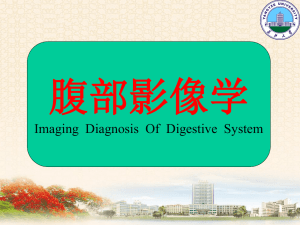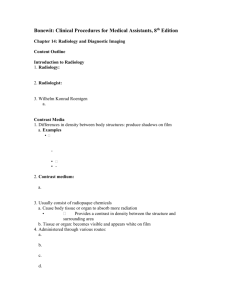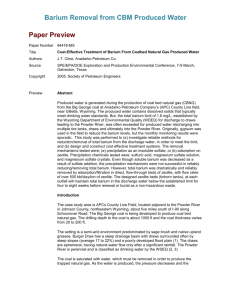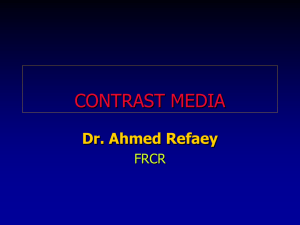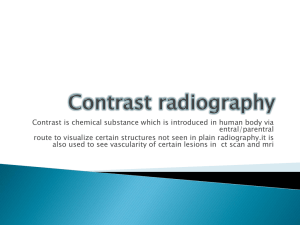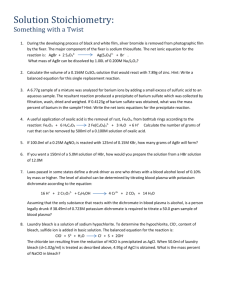הודעה על החמרה ( מידע בטיחות) בעלון לצרכן
advertisement
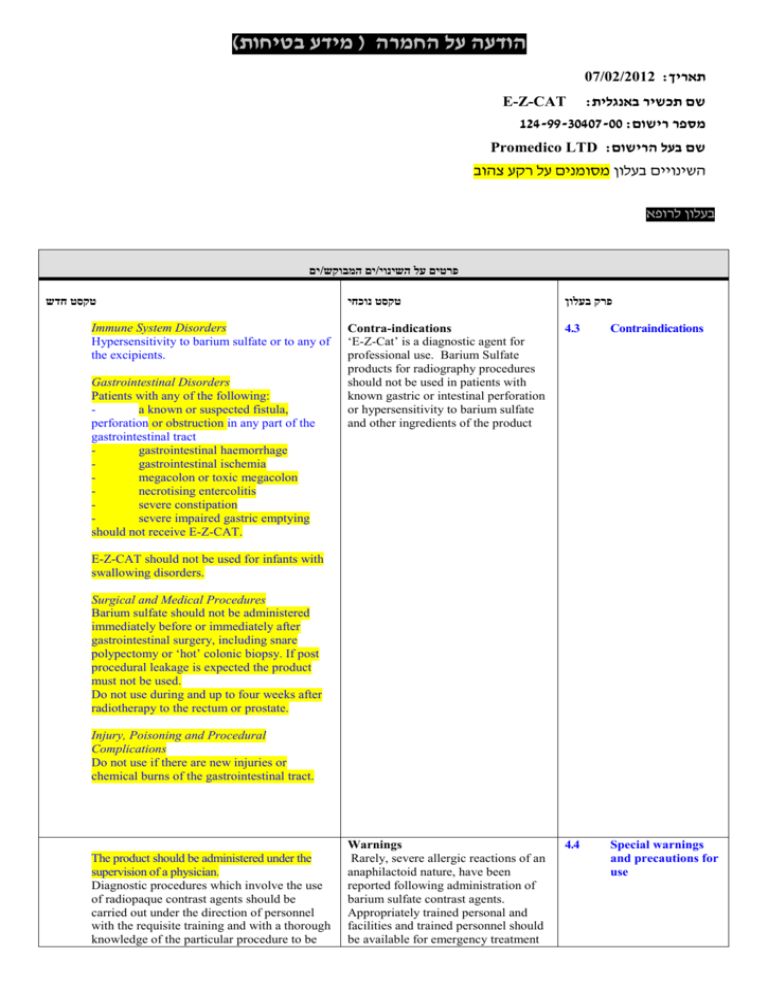
)הודעה על החמרה ( מידע בטיחות 07/02/2012 :תאריך E-Z-CAT :שם תכשיר באנגלית 421-99-70103-00 :מספר רישום Promedico LTD :שם בעל הרישום השינויים בעלון מסומנים על רקע צהוב בעלון לרופא ים/ים המבוקש/פרטים על השינוי טקסט חדש Immune System Disorders Hypersensitivity to barium sulfate or to any of the excipients. Gastrointestinal Disorders Patients with any of the following: a known or suspected fistula, perforation or obstruction in any part of the gastrointestinal tract gastrointestinal haemorrhage gastrointestinal ischemia megacolon or toxic megacolon necrotising entercolitis severe constipation severe impaired gastric emptying should not receive E-Z-CAT. טקסט נוכחי פרק בעלון Contra-indications ‘E-Z-Cat’ is a diagnostic agent for professional use. Barium Sulfate products for radiography procedures should not be used in patients with known gastric or intestinal perforation or hypersensitivity to barium sulfate and other ingredients of the product 4.3 Contraindications Warnings Rarely, severe allergic reactions of an anaphilactoid nature, have been reported following administration of barium sulfate contrast agents. Appropriately trained personal and facilities and trained personnel should be available for emergency treatment 4.4 Special warnings and precautions for use E-Z-CAT should not be used for infants with swallowing disorders. Surgical and Medical Procedures Barium sulfate should not be administered immediately before or immediately after gastrointestinal surgery, including snare polypectomy or ‘hot’ colonic biopsy. If post procedural leakage is expected the product must not be used. Do not use during and up to four weeks after radiotherapy to the rectum or prostate. Injury, Poisoning and Procedural Complications Do not use if there are new injuries or chemical burns of the gastrointestinal tract. The product should be administered under the supervision of a physician. Diagnostic procedures which involve the use of radiopaque contrast agents should be carried out under the direction of personnel with the requisite training and with a thorough knowledge of the particular procedure to be performed. Hypersensitivity A history of bronchial asthma, atopy, as evidenced by hay fever and eczema, a family history of allergy, or a previous reaction to a contrast agent warrant special attention. As stated in section 4.8, serious adverse reactions, including death, have been reported with the administration of barium sulfate formulations and are usually associated with the technique of administration, the underlying pathological condition and/or patient hypersensitivities. Anaphylactic and allergic reactions have been reported during double contrast examinations in which glucagon has been used. Rapid recognition, assessment, and diagnosis are crucial to the effective implementation of treatment. Imaging facilities should be staffed with well-trained personnel for the diagnosis and treatment of hypersensitivity reactions. Barium sulfate preparations used as radiopaque media contain a number of additives to provide diagnostic properties and patient palatability. Allergic responses following the use of barium sulfate suspensions have been reported. Skin irritation, redness, inflammation and hives have been reported for infants and small children following spillage of barium sulfate suspension on their skin. Perforation In patients with a serious stenosis at any level of the gastro-intestinal tract, especially if it is distal to the stomach, and in the presence of conditions and ailments that increase the risk of perforation such as known gastrointestinal fistulae and carcinomas, inflammatory intestinal disease, diverticulitis and diverticulosis and amoebiasis, careful consideration of the risks and benefits of the administration of a barium sulfate suspension is required. Aspiration For patients who are prone to aspiration (the newborn, elderly and stroke patients), it is recommended that the procedure starts with a small ingested volume. Vomiting following oral administration of barium sulfate may lead to aspiration pneumonitis. Oral administration of barium sulfate suspension by an infant sucking a bottle and administration of large quantities by catheter are reported to be likely to result in aspiration into the tracheobronchial tree. Cardiopulmonary arrest leading to fatality has been reported in infants following aspiration. Aspiration of smaller amounts may cause respiratory tract inflammation and pneumonia. of severe reactions and should remain available for at least 30 to 60 minutes following administration, since delayed reactions can occur. Precautions: General: Diagnostic procedures which involve the use of radiopaque contrast agents should be carried out under the direction of personnel with the requisite training and with a thorough knowledge of the particular procedure to be preformed. A history of bronchial asthma, atopy, as evidenced by hay fever and eczema, or a previous reation to a contrast agent, warrant special attention. Caution should be excercised with the use of radiopaque media in severely debilitated patients and in those with marked hypertension or advanced cardiac disease. Ingestion of this product is not recommended in patients with a history of food aspiration. If barium studies are required in these patients or in patients in whom integrity of the swallowing mechanism is unknown, proceed with caution. If this product is aspirated into the larynx, further administration should be immediately discontinued. After any barium study of the GI tract, it is important to rehydrate the patient as quickly as possible to prevent impaction of the bowel by barium sulfate.To prevent barium sulfate impaction in the bowel, the use of mild laxatives such as milk of magnesia or lactulose, following completion of the examination may also be required. These mild laxatives are recommended on a routine basis and in patients with a history of constipation unless contraindicated. Use with caution in patients with complete or nearly complete obstruction of the GI tract. Information for Patients: before administration of this product patients should be instructed to: 1. Inform their physician if they are pregnant. 2. Inform their physician if they are allergic to any drugs or food, or if they have had any prior reactions to barium sulphate products or other contrast agents used in x-ray procedures (see PrecautionsGeneral). Ingestion of barium is not recommended in patients with a history of food aspiration. If barium procedures are required in these patients or in patients in whom integrity of the swallowing mechanism ,may be compromised, proceed with caution. If this product is aspirated into the larynx, further administration should be immediately discontinued. Fluid Overload Barium sulfate suspensions have been reported to cause fluid overload due to water absorption. Children and patients with impaired renal function are the most susceptible to water intoxification, as are children with Hirschsprung’s Disease. Intravasation Barium sulfate may also intravasate into the venous drainage of the large bowel and enter the circulation as a "barium embolus". This complication occurs rarely during a barium enema and is exceedingly uncommon in oral administration. It can lead to potentially fatal complications, including systemic and pulmonary embolism, disseminated intravascular coagulation, septicaemia and prolonged severe hypotension. It is more likely to occur in elderly patients, due to thinning of the rectal wall and vaginal thinning with age, and in those with colorectal disease, when intraluminal pressure overcomes the resistance of the colonic wall affected by colitis, diverticulitis or intestinal obstruction. The diagnosis should be considered in any patient who collapses during or shortly after a barium procedure, and in those who become suddenly unwell in the hours following the procedure. The diagnosis can be confirmed by simple plain radiography; CT scanning may also be useful to detect dissemination of barium sulfate. Constipation or Diarrhoea E-Z-CAT should be used with care if the patient is dehydrated, suffers from any condition or is on any other treatment that can cause constipation, or if the patient has history of constipation. In this situation a mild bulk laxative should be administered following completion of the X-ray examination. Increased intake of liquids is recommended after oral or rectal administration of barium sulfate to prevent severe constipation and the risk of impaction. Conversely, since E-Z-CAT contains sorbitol, administration may have a mild laxative effect. The calorific value of sorbitol is 2.6 kcal/g. Other Possible Complications Apprehensive patients may develop weakness, pallor, tinnitus, diaphoresis and bradycardia following the administration of any diagnostic 3. Inform their physician about any other medications they are currently taking. agent. Such reactions are usually unpredictable and are best treated by having the patient lie flat for an additional 10 - 30 minutes under observation. Patient preparation for diagnostic gastrointestinal examinations frequently requires cathartics and a liquid diet. The various preparations can result in water loss for the patient. Patients should be rehydrated quickly following a barium sulfate suspension examination of the gastrointestinal tract. Saline cathartics are recommended on a routine basis in patients with a history of constipation unless clinically contraindicated. Baroliths consist of inspissated barium associated with faeces. They are often asymptomatic, but may be associated with abdominal pain, appendicitis, bowel obstruction, or perforation. Patients who are elderly, with impaired gastrointestinal motility, colon obstruction, electrolyte imbalance, dehydration or on a low residue diet may be at risk of developing baroliths. To reduce this risk, adequate hydration should be maintained during and in the days following barium sulfate procedure. The use of laxatives (especially in case of constipation) should be considered. Hereditary Fructose Intolerance E-Z-CAT contains sorbitol. Patients with rare hereditary problems of fructose intolerance should not use this medicine. Therefore, it should only be used in babies and small children after consultation with the doctor, due to the possibility of unknown hereditary fructose intolerance. Patients on a Controlled Sodium or Potassium diet E-Z-CAT contains sodium among the excipients. Care should be taken in patients on a controlled sodium diet, especially in the cases of repeated administration. It also contains potassium. Care should be taken with patients who have reduced kidney function or those on a controlled potassium diet. Other Excipients E-Z-CAT contains methyl parahydroxybenzoate, which may cause allergic reactions, sometimes delayed. Children, Elderly and Debilitated Patients As with any barium sulfate preparation, care should be taken when administering E-Z-CAT to children, the elderly or the debilitated. It should be used cautiously in patients with preexisting heart disease. No interaction studies have been performed. Barium sulfate is biologically inert and there are no known interactions with other medicinal products. However, The presence of barium sulphate formulation in the GI tract may alter the absorption of therapeutic agents taken concomitantly. In order to minimize any potential change in absorption, the separate administration of barium sulphate from that of other agents should be considered. Drug Interactions: The presence of barium sulphate formulation in the GI tract may alter the absorption of therapeutic agents taken concomitantly. In order to minimize any potential change in absorption, the separate administration of barium sulphate from that of other agents should be considered. 4.5. Interaction with other medicinal products and other forms of interaction Use in Pregnancy Radiation is known to cause harm to unborn fetus exposed in utero. Therefore, radiographic procedures should only be used when, in the judgement of the physician, its use is deemed essential to the welfare of the pregnant patient. 4.6. Pregnancy and lactation Other examinations of the same area of the gastrointestinal tract with another contrast agent may be complicated by the presence of barium sulfate (residue) in the gastrointestinal tract up to several days following the examination with barium contrast media. Following oral or rectal administration, barium sulfate is absorbed systemically in negligible amounts. Though barium sulfate is pharmacologically inert, no studies of its mutagenic or teratogenic potential are available. Although this product is not contraindicated in pregnancy, we would like to point out that radiographic procedures may damage the foetus, particularly during the first trimester of pregnancy. Any examination should only be carried out after careful consideration of the benefit/risk of the procedure. Nursing Mothers: Barium sulphate products may be used during lactation. Since the absorption of barium sulfate is negligible, its use is not contraindicated during breastfeeding. 4.7 Effects on ability to drive and use machines 4.7. Effects on ability to drive and use machines 4.8. Undesirable effects E-Z-CAT has negligible influence on the ability to drive and use machines. 4.8 Undesirable effects Undesirable effects may occur during or after a procedure with barium sulfate. Skin and subcutaneous disorders together with immune system disorders, reflecting allergic reactions either to barium sulfate or the product excipients, are among the most commonly reported effects; for example urticaria, erythema and rash. Gastrointestinal disorders are also one of the most frequently reported class of undesirable effects; for example diarrhoea, nausea, abdominal pain/distention, constipation. Within the table below, clinically significant Reactions: Adverse reactions, such as nausea, vomiting, diarrhea and abdominal cramping accompanying the use of barium sulfate formulations are infrequent and usually mild. Sever reactions (approximately 1 in 1,000,000) and fatalities (approximately 1 in 10,000,000) have occurred. Procedural complications are rare, but may include aspiration pneumonitis, barium sulfate impaction, granuloma, formation, intravasation, embolization and peritonotos following intestinal perforation, vasovagal and syncopal episodes, and fatalities. It is of the utmost importance to be completely prepared to treat any such occurrence. adverse reactions are listed if they have been reported during post approval use of all barium sulfate formulations. Their frequency is not known, therefore relative reporting rate (for example, less commonly) compared to overall reporting for barium sulfate is used. MedDRA Preferred Term MedDRA System Organ Class Appendicitis, Bacteraemia. Less commonly other infections have been reported including rare cases of Abscess intestinal, Liver abscess, Peritoneal infection and Pneumonia Infections and infestations Lymphadenopathy Blood and the lymphatic system disorders Hypersensitivity presenting with a wide range of signs and symptoms including skin and subcutaneous reactions such as urticaria, pruritus, rash, erythema and facial swelling. Potential hypersensitivity associated respiratory signs and symptoms including dyspnoea, pharyngeal oedema and throat tightness have been reported. Anaphylactic reaction and anaphylactic shock have been reported less commonly. Immune system disorders Infrequent cases of Hyperglycaemia have been reported in diabetic patients Metabolism and nutrition disorders Agitation, Confusional state, Nervousness and related symptoms have been reported during the administration of barium sulfate Psychiatric disorders Loss of consciousness, Syncope, Syncope vasovagal, Dizziness, Nervous system disorders Allergic Reactions: Due to the increased likelihood of allergic reactions in atopic patients, it is important that a complete history of known and suspected allergies as well as allergic-like symptoms, e.g.,rhinitis,bronchial asthma,eczema and urticaria, must be obtained prior to any medical procedure utilizing these products. A mild allergic reaction would most likely include generalized pruritus,erythema or urticaria (approximately 1 in 250,000). Such reactions will generally respond to an antihistamine such as 50mg of diphenhydramine or its equivalent. In the rarer more serious reactions (approximately 1 in 1,000,000) laryngeal edema, bronchonspasm or hypotension could develop. Severe reactions which may require emergency measures are often characterized by peripheral vasodilation, hypotension, reflex tachycardia,dyspnea, agitation, confusion and cyanosis progressing to unconsciousness. Treatment should be initiated immediately with 0,3 to 0,5 ml of 1:1000 epinephrine subcuteneously. If bronchospasm predominates, 0,25 to 0,5 gr of intravenous aminophylline should be given slowly. Appropriate vasopressors might be required. Adrenocorticosteroids, even if given intravenously, exert no significant effect on the acute allergic reactions for a few hours. The administration of these agents should not be regarded as emergency measures for the treatment of allergic reactions. Apprehensive patients may develop weakness, pallor, tinnitus, diaphoresis and bradycardia following the administration of any diagnostic agent. Such reactions are usually non-allergic in nature and are best treated by having the patient lie flat for an additional 10 to 30 minutes under observation. Burning sensation, Headache, Dysarthria, Hypotonia Eye disorders, including Eye swelling, usually associated with allergic reactions have been reported Eye disorders Tinnitus Bradycardia, Cyanosis, Tachycardia Ear and labyrinth disorders Cardiac disorders Hypotension, Pallor, Vasodilatation Vascular disorders Bronchospasm, Dyspnoea, Laryngeal oedema, Pharyngeal oedema and pain, Throat irritation or tightness, Cough. When administered orally, Aspiration, Pneumonia aspiration. Respiratory, thoracic and mediastinal disorders Gastrointestinal signs and symptoms are widely reported, it is not always possible to differentiate between pre-existing medical conditions and procedural complications. Events reported include: Constipation and in severe cases gastrointestinal blockage; Gastrointestinal inflammation, ulceration or perforation; Abdominal discomfort, Abdominal pain and distension; Diarrhoea; Colitis ulcerative may be aggravated; Nausea; Vomiting and Retching; Flatulence; Swollen tongue Gastrointesti nal disorders Skin reactions are varied and most likely to be associated with allergic reactions. Reports include: Erythema, Dermatitis Contact, Excessive granulation tissue, Hyperhidrosis, Periorbital oedema, Pruritus, Rash, Skin and subcutaneou s tissue disorders Swelling face, Urticaria Dysuria Malaise, Pain, Swelling, Asthenia, Pyrexia, Face oedema Renal and urinary disorders General disorders and administrati on site conditions Electrocardiogram abnormal Investigatio ns Intravasation by barium sulfate, associated with pre-existing bowel disease or diverticulitis, has been reported rarely Injury and poisoning More rarely and depending on the route of administration, i.e. oral or rectal, the following procedural complications have been reported: Infections (e.g. peritonitis) subsequent to existing or new gastrointestinal perforation. Complications include adhesions and granuloma. Subsequent to existing or procedural gastrointestinal trauma, intravasation of barium sulfate with rare subsequent venous emboli formation, including the hepatic portal vein, vena cava and pulmonary embolism that may be fatal in approx 50% of cases. Following oral administration, aspiration, with pulmonary complications, may occur and may be fatal in rare cases. Please see section 4.4 for measures to be taken to avoid these adverse reactions, and actions to take if such adverse reactions occur. Very rare cases of death associated with barium sulfate administration have been reported in the literature. The majority of the deaths relate to procedural complications usually caused by failure to follow generally accepted radiological practice. Some cases had a history indicating that barium sulfate administration was highly unlikely to be a primary or even secondary causative factor in patient fatality Barium sulfate is non-toxic and absorbed systemically in negligible amounts. Repeated use within a very short period of time has led to abdominal cramps, nausea, vomiting, diarrhoea, and constipation. These symptoms are transitory in nature and may be allowed to resolve without medical intervention or may be treated according to currently accepted standards of care. Overdosage: On rare occasions following repeated administration, severe stomach cramps, nausea, vomiting, diarrhea or constipation may occur. These are transitory in nature and are not considered serious. Symptoms may be treated according to currently accepted standards of medical care. Dosage and administration: The volume and concentration of E-Z-CAT to be administered will depend on the degree and extent of contrast required in the area(s) under examination and the equipment and technique employed. Shake well before use. E-Z-CAT is intended for dilution prior to administration. Mixing Instructions: Pour contents into supplied mixing container. Add water to slightly below top of the container. Close the lid and shake the container well. Yield: 900 mL of 1.2% w/w barium sulphate suspension. Alternately, E-Z-Cat barium sulphate suspension may be mixed to yield a different density. Some suggestions are as follows: Add E-Z-Cat contents into the mixing Container and add water to the 700 mL level. Yield: 700mL of a 1.5% w/w suspension. Add water to the 600mL level. Yield: 600 mL of a 1.7 w/w suspension. Add water to the 500 mL level. Yield: 500 mL of a 2.1% w/w suspension. Suggested 30 minutes barium administration protocol for Abdomen Studies: Administer 300 mL of E-Z-Cat. 30 minutes before scan and 150 mL immediately prior to scan; or use as directed by physician. Suggested 30 Minute Barium Administration Protocol for Abdomen/Pelvis Studies: Administer 300 mL E-ZCat, 30 minutes before scan and 150 mL immediately prior scan. Then administer a barium enema using E-Z-EM's 400 mL CAT-PAKTM CT enema system (Cat. No. P410); or use by physician. Suggested 90 Minute Barium Administration Protocol for Abdomen/Pelvis Studies: Administer 450 mL E-ZCat, 90 minutes before scan, another 300 mL 30 minutes before scan, and 150 mL immediately prior scan; or use as directed by physician. Other dosing regimen may be followed as applicable. Any unused, opened product or waste material should be disposed of in accordance with local requirements. The volume and concentration of E-ZCAT to be administered will depend on the degree and extent of contrast required in the area(s) under examination and the equipment and technique employed. Mixing Instructions: Pour contents into supplied mixing container. Add water to slightly below top of the container. Close the lid and shake the container well. Yield: 900 mL of 1.2% w/w barium sulphate suspension. Alternately, E-Z-Cat barium sulphate suspension may be mixed to yield a different density. Some suggestions are as follows: Add E-Z-Cat contents into the mixing Container and add water to the 700 mL level. Yield: 700mL of a 1.5% w/w suspension. Add water to the 600mL level. Yield: 600 mL of a 1.7 w/w suspension. Add water to the 500 mL level. Yield: 500 mL of a 2.1% w/w suspension. Suggested 30 minutes barium administration protocol for Abdomen Studies: Administer 300 mL of E-Z-Cat. 30 minutes before scan and 150 mL immediately prior to scan; or use as directed by physician. Suggested 30 Minute Barium Administration Protocol for Abdomen/Pelvis Studies: Administer 300 mL E-Z-Cat, 30 minutes before scan and 150 mL immediately prior scan. Then administer a barium enema using E-Z-EM's 400 mL CAT-PAKTM CT enema system (Cat. No. P410); or use by physician. Suggested 90 Minute Barium Administration Protocol for Abdomen/Pelvis Studies: Administer 4.9. Overdose 6.6 Special precautions for disposal and other handling 450 mL E-Z-Cat, 90 minutes before scan, another 300 mL 30 minutes before scan, and 150 mL immediately prior scan; or use as directed by physician. Other dosing regimen may be followed as applicable.

